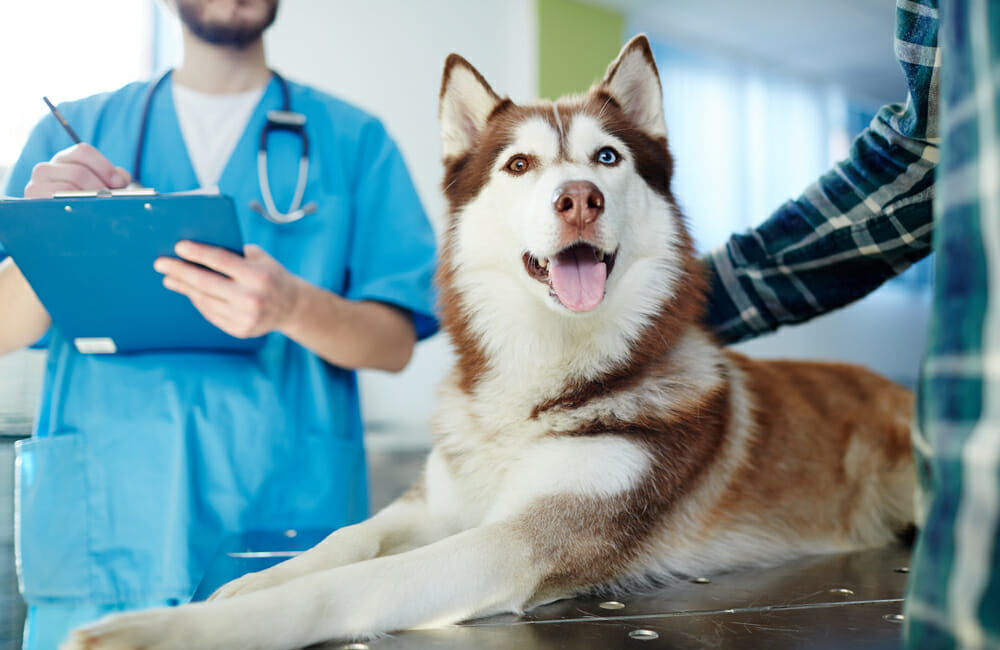Taking your pet to the vet may not be everyone’s favourite thing to do. There are many things that can be done to make the trip as successful and stress-free as possible, for the pet, owner, and veterinary team. I work in a busy emergency vet hospital that sees both regular/routine appointments as well as walk-ins. These are the things that I’ve noticed our clients doing that have made for the most streamlined visits with happy pets and satisfied clients.
Relax and Be Positive
If you want to make your pets trip to the veterinarian easier on you, your pet, and the veterinary team, the best thing to do is try to relax. Our pets are often attuned to our mood, so if you walk into the vet with a calm and positive attitude, your pet often will too. The more relaxed your pet is, the smoother the appointment goes. (This also has a similar effect on your veterinary team!) We understand that sometimes this isn’t always possible if your wait time is longer than anticipated. The common goal is the same for everyone: to keep your pet happy and healthy.
Positive reinforcement is also extremely important for pets when going to the vet. Bringing them in when they are a bit hungry and giving lots of treats (*unless they need to be fasted) will always make for a better visit.
Call Ahead or Book an Appointment
Whether you are calling to book a yearly vaccine appointment or a nail trim, let us know that you’re coming (and when and for what reason). Some hospitals offer walk-in services for this, and even the ones that don’t will sometimes try to squeeze you in – but you may not get the most out of your “squeezed in” appointment compared to a scheduled appointment.
Tell Us Why You’re Coming (or anything else we should be made aware of)
This one is a little redundant, but important nonetheless. If you have multiple concerns, it is important to tell the customer care staff this at the time you book your appointment (e.g. a new or growing lump, an ear infection, lameness, etc.). It is important so that we can set aside the appropriate amount of time, and because sometimes we may not be able to address multiple concerns at the same visit. For example, if your pet has an infection and is also due for vaccines, then we may postpone the vaccines until your pet is healthy. In general, it is best to bring your pet in right away when you notice a problem so that it can be addressed, and not wait until there are two or three problems. It results in better outcomes for your pet and a better quality of life.
If you or your pet have specific requirements that need to be addressed, let us know ahead of time. For example, if your dog is reactive to other dogs, men or women, or becomes leash aggressive, we can arrange for you to be put in a room immediately or wait in your car for your appointment. If your pet is anxious or aggressive at the vet, we may be able to prescribe an anti-anxiety medication ahead of time to help relax them and make the visit less stressful.
If you are cost-sensitive let us know. We can often alter our diagnostic plan or treatment plan to meet your budget. Most hospitals also work with credit companies to offer payment plans, but sometimes these take time to be approved, so letting us know as soon as possible is important.
Be Prepared and Plan Ahead
Bringing your pet to the vet can be overwhelming sometimes, so it helps to write down any specific questions or concerns you may have or any information you don’t want to forget. Make a note of your pet’s diet (i.e. the specific type of food your pet is fed, amount, frequency, etc.) water intake, any treats they receive on a regular basis, and if they are taking any additional supplements. Also note any changes in urination or bowel movements, including frequency, volume, colour, odour, or consistency. Collecting samples at home and bringing them to your appointment can provide a lot of additional information (e.g. a urine sample for urinary issues, a stool sample for bowel issues, etc.), as can taking pictures or videos of certain behaviors your pet is doing that may not be repeated during the appointment (e.g. a particular cough, sneezing, or seizures).
If you’re afraid you will forget something discussed during the appointment, ask us to write it down or bring a friend (four ears are better than two!), and if we provide additional information, please read it!
When transferring to a new veterinary hospital, having your records transferred prior to your visit will allow us to review your file ahead of time and will also save time during your appointment.
Keep Your Pet on a Leash or in a Safe Carrier
I’ll be honest, I’ve seen it all when it comes to pet carriers. I’ve seen cats brought in to the vet in suitcases, in pillowcases, in laundry baskets, or simply carried in their owners’ arms without a harness. I understand, it gets the job done, but it isn’t always safe, relaxing for the pet, or practical for you or the veterinary team. Bringing your pet in a clean, appropriately sized carrier that is easy to assemble and disassemble always makes things run more smoothly. It is also extremely important to keep dogs leashed while at the vet, even if they are normally friendly. The dog sitting next to your dog may not be as friendly, or there may be a cat nearby that doesn’t like dogs. Your dog also may not act the way they normally do if they are feeling sick or in pain. Having your dog on a leash makes things safe for everyone.
Make Car Rides Positive
For many pets, a trip in the car can often end poorly (in their minds) – for example, a trip to the groomer, the vet, or they may get car sick. It is often worse for cats. It can be helpful to take your dog for more car rides to mix things up, such as to the park or to the pet store for a treat (or to the vet, just to say hello and become more comfortable in the hospital), so that they don’t become anxious before they even arrive. For cats, more frequent car rides may not be possible, but letting the cat out of the carrier as soon as possible and rewarding them with treats can make things more positive. It is also helpful to let us know if your cat doesn’t travel well when you are booking your appointment, so we can try to have a room available upon your arrival so they can be let out sooner.
There are many options when it comes to preventative medicine for your pet: some are given monthly, or every three months, some are over the counter or require a prescription, and there are also topical or chewable formulations. It is important to have a preventative medicine conversation with your veterinarian to find what works best for you and your pet.
Give us a call and book your appointment today!
Written by: 4Paws Veterinary Hospital




